Erica imbricata
Erica imbricata L.
Family: Ericaceae
Common names: salt and pepper heath, rinkhals heath (Eng.) raasheide, ker-ker, witkarkaar (Afr.)
Introduction
Erica imbricata produces masses of small white bell-shaped flowers with deep black anthers, giving a distinctive two-tone effect and providing forage for honey bees.
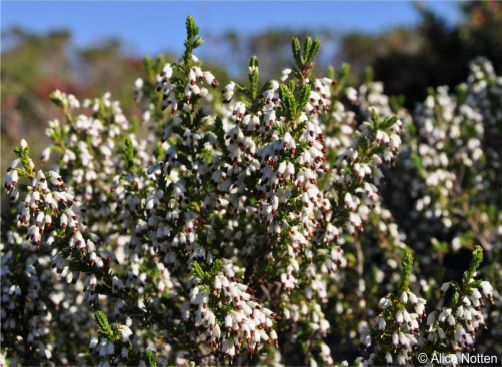
Description
Description
Erica imbricata is an upright, rounded or wand-like shrublet to 900 mm tall, with ascending branchlets and numerous additional short-shoots. Leaves are in whorls of four, needle-like and microscopically hairy. Flowers white or pink, mostly in threes, nodding on short stalks at the tips of the branchlets and short-shoots, and are aggregated into dense false-racemes. The bracteoles are large and petal-like, papery, pressed against the calyx and coloured like the corolla. The sepals are large and petal-like, keel-tipped, papery, about as long as, and the same colour as the corolla. The corolla is urn-shaped or sometimes almost radish-shaped, 4-grooved, 2-3.5 mm long, concealed by the sepals, hairless, white, lobes erect, rounded. There are 8 anthers, all fully protruding from the corolla, tapering at the base. The style protrudes beyond the anthers, sometimes curved, the stigma shaped like a pinhead. Plants flower throughout the year but mainly in winter, spring and early summer (June to December).
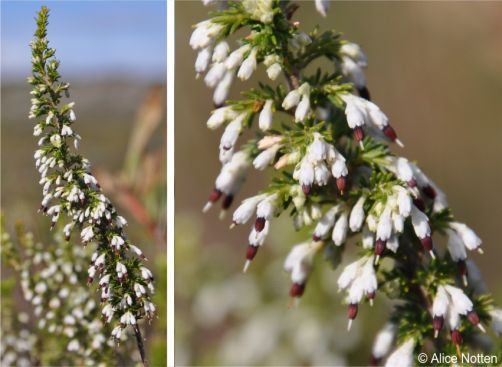
Conservation Status
Status
Erica imbricata is widespread and common and was automatically given Least Concern (LC) status by the Red List of South African Plants; the taxon was not selected in any of four screening processes for highlighting potential taxa of conservation concern for detailed assessment.
Distribution and habitat
Distribution description
Erica imbricata is endemic to the Western Cape province of South Africa. It is widely distributed where fynbos it is at its richest, from near Vanrhynsdorp to the Cape Peninsula and eastwards along the coastal ranges and mountains of the Little Karoo to Joubertina. It is found growing in different habitats, from dry coastal flats to mountain slopes.
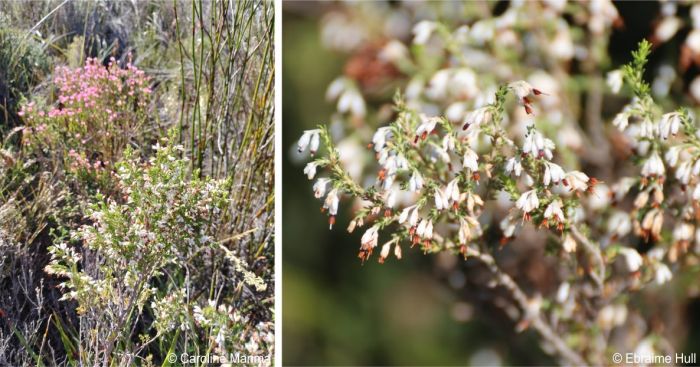
Derivation of name and historical aspects
History
The species name imbricata derives from the latin word imbricatus, meaning ‘overlapping’, referring to the predominant calyx overlapping the corolla. It is commonly known as salt & pepper heath because of the black and white flowers which give a distinctive two-tone effect, and ker-ker and raasheide (meaning noisy heath) for the sound that the plant makes when brushed against.
The genus Erica is by far the largest in the Cape Floristic Region (CFR), made up of 842 accepted species that occur in Europe, the Arabian Peninsula and Africa, with almost 700 species species (80%) that are restricted to the CFR, which extends from near Nieuwoudtville in the north to the Cape Peninsula in the south and eastwards to Gqeberha (previously known as Port Elizabeth).
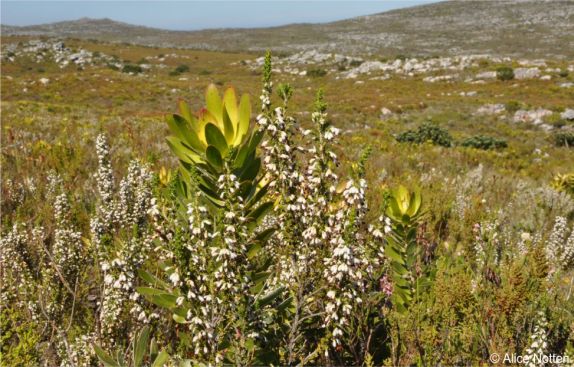
Ecology
Ecology
Apart from the genus being known for its species diversity, it also exhibits a range of specialized pollination systems, which exist in co-flowering Erica species in CFR communities. Pollinators of ericas include birds, ants, beetles, flies, moths, solitary bees and Cape honey-bees (Apis mellifera capensis). In the case of Erica imbricata, the main pollinator is the Cape honey-bee. The species is self-incompatible meaning it is unable to be fertilized by its own pollen, which means it needs pollen from other plants in the population to produce viable seeds.
Ericas are well adapted to CFR climatic conditions and frequent fires. They are able to survive in nutrient-poor soils associated with sandstones. Their reseeding and resprouting adaptive traits have made it possible for them to survive the fires that frequently sweep through fynbos, and the climatic changes of the CFR over time. Their small, needle-like foliage is a response to its native, wind-swept habitat and summer drought, enabling the plant to survive by reducing water loss through the leaves.
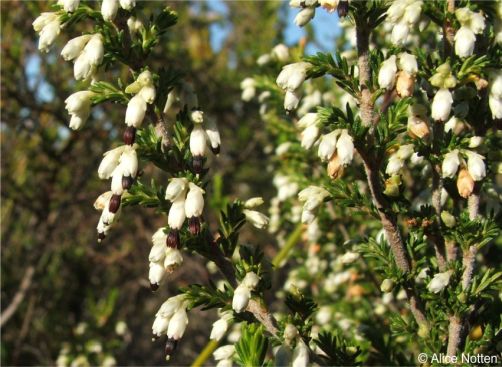
Uses
Use
Erica imbricata has no medicinal or cultural properties but it has horticultural appeal, and it can be grown and planted in the garden where it will add interesting two-tone flower colour to flowerbeds. It can also be harvested for cut-flowers, providing uniform grading, strong stem and solid vase life.
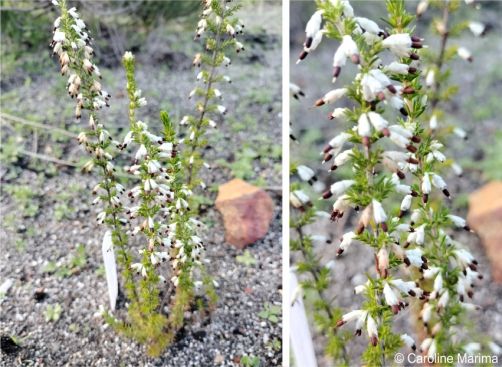
Growing Erica imbricata
Grow
Erica imbricata can be propagated by seeds and cuttings and planted out in the garden. It is best suited where the soils are acidic, poor in nutrients with good drainage, even better if incorporated with soil derived from sandstone, and is ideally suited to mountain fynbos gardens. It can be hardy if planted in the right conditions where it receives full sun, with cool, moist conditions. To grow it, plant in late autumn to early winter when temperatures have cooled, water every 1-2 weeks until it is established whereafter it will be moderately drought-tolerant.
Collect seeds that are healthy, disease-free and viable, and sow them in autumn, in a well-drained seedling mix suitable for fynbos. To achieve a moderate to high germination rate, perform smoke treatment on the seeds and give it two months or so to germinate.
For cuttings, collect semi-hardwood cuttings from healthy plants, treat with rooting hormone and place in well-drained growing medium, preferably a mixture of fine-milled bark mixed with perlite at a ratio of 1:1 and place them in a controlled mist environment with bottom hating of ±24°c. Once rooted, pot them up into a potting mix suitable for fynbos, which is well-drained and acidic with pH of 5.5-6.7 and harden off in light shade for a month or two. When ready, plant out in the garden and ensure not to disturb the roots.
If well taken care of, and planted in a well-drained position with free air circulation, pest and fungal control should not be a problem.
References
- Burman, l. & Bean, A. 1985. Hottentots Hollands to Hermanus. South African Wild Flower Guide 5. Botanical Society of South Africa, Cape Town.
- Fernkloof Nature Reserve. Erica imbricata. https://www.fernkloof.org.za/index.php/all-plants/plant-families/item/erica-imbricata. Accessed on 2025/11/04.
- Goldblatt, P. & Manning, J. 2000. Cape Plants. A conspectus of the Cape flora of South Africa. Strelitzia 9. National Botanical Institute, Pretoria & Missouri Botanical Garden, Missouri.
- Helme, N. & Manning, J. 2024. Ericas of the Fynbos. Published by Struik Nature.
- Hoekstra, R.D., Musker, S.D., Pirie, M.D. & Vlok, J.H.J. 2025. An integrative approach to alpha taxonomy in Erica L. (Ericaceae) with three new species from the Western Cape, South Africa. Phytokeys 257:95-117.
- Life is a Garden. All about ericas. https://www.lifeisagarden.co.za/all-about-ericas/. Accessed on 2025/11/04.
- Ozflora. Erica imbricata. https://www.ozflora.co.za/product/erica-imbricata-salt-and-pepper/. Accessed on 2025/11/04.
- Plants of the World Online. Erica Tourn. ex L. https://powo.science.kew.org/taxon/urn:lsid:ipni.org:names:30249382-2. Accessed 17/11/2025.
- Raimondo, D., Von Staden, L., Foden, W., Victor, J.E., Helme, N.A., Turner, R.C., Kamundi, D.A. & Manyama, P.A. (eds) 2009. Red list of South African plants. Strelitzia 25. South African National Biodiversity Institute, Pretoria.
- Stodels. All about ericas. https://www.stodels.com/growing-ericas/. Accessed on 2025/11/04.
- Van der Niet, T. Pires, K. & Steenhuisen, S.-L. 2017. The role of the pollination niche in community assembly of Erica species in a biodiversity hotspot. Journal of Plant Ecology 10: 634-648.
- Van der Niet, T. Pires, K. & Steenhuisen, S.-L. 2020. Flower constancy of the Cape honey bee pollinator of two co-flowering Erica species from the Cape Floristic Region (South Africa). South African Journal of Botany 132:371-377.
- Vlok, J. & Schutte-Vlok, A.L. 2010. Plants of the Klein Karoo. Umdaus Press, Hatfield.
Credits
Caroline Marima
Harold Porter National Botanical Garden
November 2025
Acknowledgements: the author thanks Ebraime Hull for providing some of the photos taken at Fernkloof Nature Reserve during a plant collection visit and Alice Notten for photos taken on the Cape Peninsula.
Plant Attributes:
Plant Type: Shrub
SA Distribution: Western Cape
Soil type: Sandy
Flowering season:
PH: Acid
Flower colour: Black, White
Aspect: Full Sun
Gardening skill: Average
Special Features:
Horticultural zones
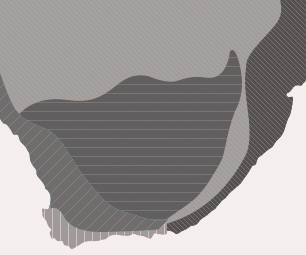







Rate this article
Article well written and informative
Rate this plant
Is this an interesting plant?
Login to add your Comment
Back to topNot registered yet? Click here to register.